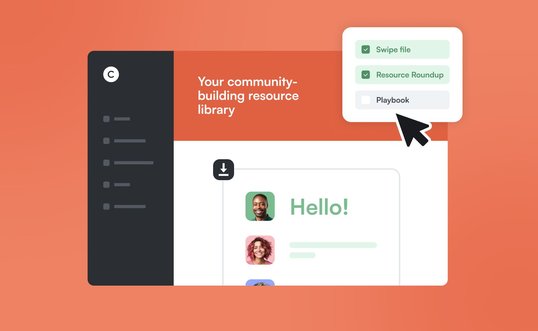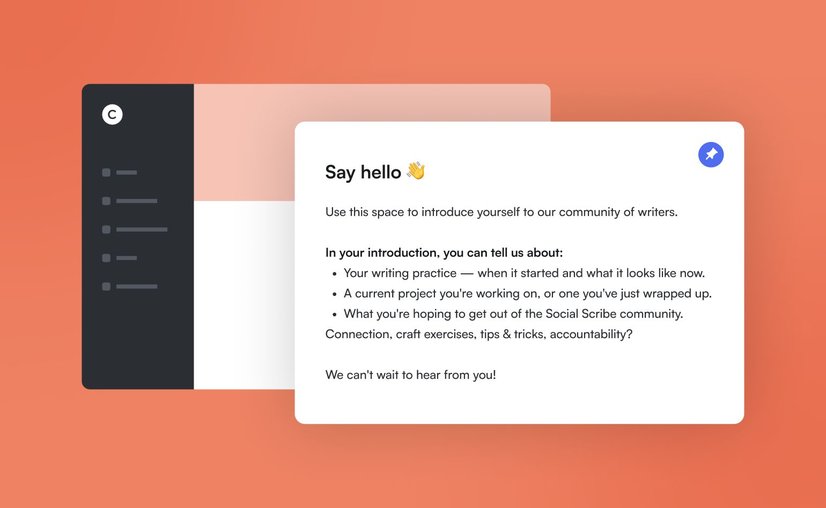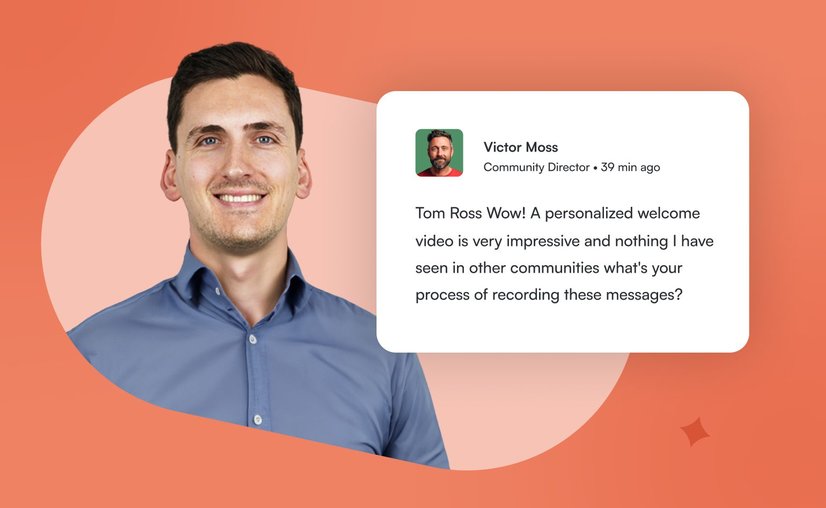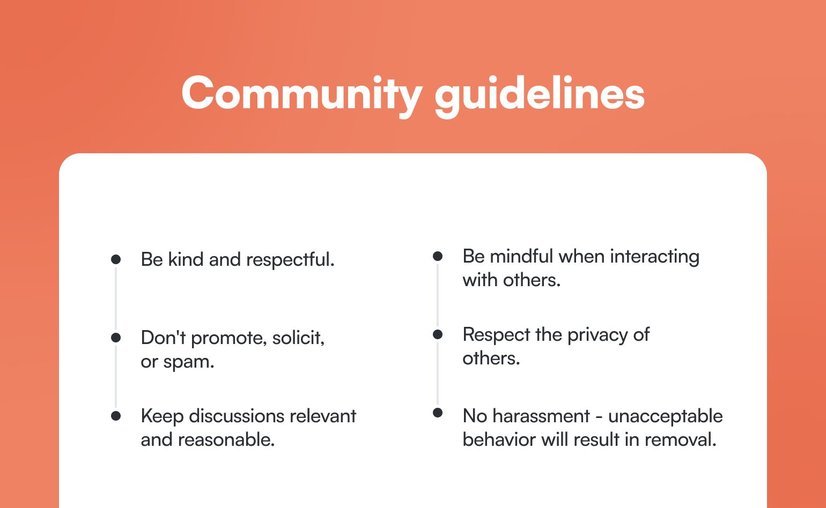The 5-step playbook for meaningful online community engagement
When it comes to community, engagement is one of those topics that can feel nebulous and overwhelming.
So, we’ve broken it down into simple steps.
In this playbook, you’ll learn how to:
- Define engagement in a way that’s relevant to your online community.
- Design community programming for optimal engagement.
- Remove obstacles to engagement and make it simple for members to take action.
- Lead by example to encourage engagement.
- Test new strategies, iterate as you go, and hear directly from members on what works.
Whatever your specific community engagement goal is, we’re confident that this playbook will help you add new tools to your toolkit.
1. Get clear on what “engagement” means
Before we can explore how to spark meaningful engagement in an online community, we need to revisit existing beliefs about engagement and start to define engagement more holistically.
Engagement doesn’t simply equal participation—it’s much more nuanced. How you define engagement will be totally unique to your community.
👉 Engagement looks different for every community.
The days when engagement was defined by comments and likes are long gone.
For the sake of this playbook, we’ll be using the term “engagement” to refer to any meaningful actions your members take in your community. This can mean participating in an event, sharing a progress update in an accountability space, even discovering a helpful resource in a resource library.
Because every community is different, engagement will look different from one community to the next.
👉 Consider your “why”.
If you’d like to understand what engagement means in the context of your community, consider the value you’re hoping to provide to your members—this is your “why”.
In the Circle community, for example, our why is helping Circle users build successful communities: we want to offer education, inspiration, and connection so that their communities can thrive.

If you’re still figuring out your why, consider the transformation you’re offering to your members and how the community will support them in achieving that transformation. Getting crystal clear about this will help you define what meaningful engagement looks like in your community.
Imagine that you run an online community for individuals looking to pivot in their careers and your why is helping your members to secure new job opportunities.
One day, one of your members posts about a movie he saw over the weekend and several other members join the discussion. While the post may be receiving plenty of comments and likes, this is not an example of meaningful engagement because it doesn’t support your why. Members who participate in this discussion are no closer to securing new job opportunities as a result.
👉 Define your engagement metrics.
Now that you have a better understanding of what meaningful engagement looks like, you can start to define your own community engagement metrics.
These metrics should map back to your why and focus on the most meaningful actions members take in your community.
So, ask yourself:
- What are the actions that drive real impact in your community?
- What actions can members take to bring them one step closer to achieving the transformation you’re offering?
“[In my community], one of our metrics is # of members who’ve made a new friend in the community. We haven’t figured out a foolproof way to consistently measure this. Yet, just having it as one of our goals guides our actions and the experiences we design and in turn, makes the community more engaging.”
👉 Keep in mind that not all members will engage in the same ways.
Your community members will not all engage to the same extent or in the same ways.
Some members will get a ton of value from being active and visible, while other members will also get a ton of value from enjoying the community in a more passive way. And it’s important to note that even your most engaged members will go through phases of being more engaged and phases of being less engaged—that’s just the reality of running a community.
Once you understand that this is totally normal and not a problem to be solved, you’ll free up a lot of mental space to focus on what you actually can control.
2. Revisit your programming
Programming includes all of the events, activities, and discussions that you organize for your community.
When your programming aligns with your why and supports your members in achieving their goals, engagement will naturally follow.
👉 Does your programming map back to your why?
Consider any regular rituals or activities that you run in your community—do they support the value you’re hoping to provide through the community? Do they help members get closer to achieving their goals?
Let’s say your community exists to help people advance in their careers. Offering a discussion space for your members to discuss the TV shows they’re loving might be fun, but it doesn’t actually align with your overarching mission.
A better option might be to offer workshops on topics such as interviewing and salary negotiation.

👉 Does your programming meet your members where they are?
Maybe your members are busy executives who simply don’t have a free hour on Monday mornings to join your office hours. If that’s the case, it might make more sense to offer evening or weekend sessions, or consider options for engaging with your members asynchronously.
Consider what a day in the life of your typical member looks like. Then, make sure to adjust your programming accordingly.
You might also want to aim for some combination of live and async experiences: maybe your rituals are a live weekly coworking session and an async discussion space where members can share their goals every Monday.
👉 Narrow your focus to expand your impact.
Are you trying to cram in too much programming in an attempt to deliver more value to your members?
If so, challenge yourself to focus on just two to three rituals or recurring activities. By doing these two or three things exceptionally well, you’ll actually be able to deliver more value to your members.
And if you’re having trouble deciding which rituals and activities to focus on, consider what’s already driving the most impact for your members.
👉 Create a content calendar.
Now that you’re clear on your programming, it’s time to figure out when, where, and how frequently you’ll offer all of it.
You can achieve this by creating a simple content calendar that outlines:
- Any programming you’ve planned for the community (including posts, events, content, challenges, etc.)
- Whether each item is a recurring or one-off initiative
- A publication or go-live date for each item
If you want to take this one step further, you can share this content calendar with your community members. This way, they know what’s coming up and when.
She says, “This also is VERY helpful as a planner. It means you need to select 12 topics for the entire year, and it offers a simple framework to create content.”
We’ve actually implemented this strategy in the Circle community, and it has made content planning so much easier! We simply choose a topic for each month and map out content, resources, and programming that support that topic.
3. Make member participation easy
Want to know one of the most underrated engagement hacks?
Make it exceptionally easy for your members to take action—you’d be surprised to know how many of your members won’t know how to participate meaningfully in the community until you spell it out for them!
👉 Tell your members how to take action.
Don’t leave your members guessing—tee up each space in your community with a pinned post that clearly outlines the action members should take in that space.
Let’s say you have a space in the community where members can share their goals. For this space, you might draft a pinned post that asks members to:
- Post their top goal for the week on Monday
- Post again on Friday with an update on their progress
This kind of structure frees up a lot of mental space for your members, because it tells them exactly how they should be participating.
👉 Share prompts and thought starters.
Prompts and thought starters are great ways to free up mental space for your members and inspire them to participate.
For example, if you’re asking members to introduce themselves, try offering some ideas for details. These could include:
- Where they’re from
- What they do for work
- Why they’ve joined the community
- And so on
The pinned posts in your spaces are a great place for these prompts, but you can also use prompts when you’re trying to encourage discussion during live events and experiences.

👉 Tag members into the conversation.
As a community builder, part of your job is being a connector.
If there’s a discussion going on in the community and you know that a specific member would have really interesting insights to share on the topic, tag them and let them know. Or, if a new member introduces themselves and you just know they’d get along brilliantly with another community member, tag the other member so they can connect. Or, if you’re hosting an event that you know is right up a specific member’s alley, tag them and ask them to attend.
👉 Remind members of where, how, and when they should participate.
Don’t assume that your members will remember to do something just because you told them about it once—if you want them to make a certain behavior a habit (for example, sharing their wins from the week in a “Share Your Wins” space every Friday), you’ll need to remind them to do so multiple times.
You might choose to take time during a live event to remind them of this, or you might consider sending automated DMs with workflows to remind them to take action.
4. Model desired behaviors
At the end of the day, it’s your responsibility to set the tone for your community’s culture. If you want to encourage members to engage meaningfully in the community, one of the absolute best things you can do is lead by example.
👉 Welcome new members when they introduce themselves.
Posting an introduction is often the first step most members will take upon joining a new community, so it’s especially important to acknowledge when a member introduces themselves.

If your member posts a thoughtful introduction but is met with radio silence, they won’t have much of an incentive to return to the community. So, giving them a warm welcome to make them feel appreciated right from the start is a relatively-easy way to increase community engagement going forward.
👉 Share your own stories and insights.
Model the types of contributions you’d like to see from members by sharing your own stories and insights.
For example, if you have a space in your community where you’d like members to share an update on their progress each week, why not get the ball rolling by sharing your own update?
👉 Respond to member posts in a timely manner.
When a member posts something new, acknowledge their effort and contribution by responding promptly.
This doesn’t mean that you should check the community every few minutes for new activity but, as a best practice, aim to respond to posts that haven’t yet received an answer within 24 hours.
By doing this, you’re setting the example for other community members and making the member who posted feel seen. This increases the likelihood that they’ll participate in the community again.
👉 Take the time to provide thoughtful responses to members’ posts.
In addition to responding to your members’ contributions in a timely manner, aim to provide truly thoughtful and valuable responses.
When drafting a response, take time to consider the member and their post:
- Was there a specific insight that stood out to you?
- Did they share a tip or idea that you’re keen to implement yourself?
- Is there a specific community resource, event, or conversation that might be good to share with them?
- Are there other community members who have done something similar who you can loop into the conversation?
Think of your response as an opportunity to create even more value for your member.
👉 Acknowledge members’ contributions.
Want your members to contribute more? You can encourage this behavior by thanking your members when they do contribute.
Whether they’re asking for guidance in the community, sharing their perspective during a live event, or offering support on another members’ thread, be sure to acknowledge the members’ contribution and thank them for it.
Sharing takes time, thought, and (in many cases) courage, so be sure to let your members know that you appreciate their efforts!
5. Test and iterate aspects of your community engagement approach
No great community was ever built in a vacuum!
Any successful online community builder will tell you that a healthy dose of trial and error is all part of the journey.
👉 Ask your members for feedback.
Is your programming relevant to your members? Do you give your members enough opportunities to connect? Is there something you can change about your community’s structure to help members unlock more value?
Ask your members these questions, and then adjust accordingly.
There are plenty of ways to ask your members for feedback, so pick the method that works best for you. Options include:
- Sending around a survey after a big event or initiative
- Checking in with members via DM
- Conducting interviews with individual members
- Starting a discussion in the community to ask members for feedback
👉 Pay attention to member behavior.
You can learn a lot by simply paying attention to where your members are engaging most and where they’re engaging least.
Maybe your members are super active in a discussion space, but they don’t show up to your weekly live events. That tells you something about the event isn’t resonating with your members.
Instead of guessing why this might be (is it the content of the event? the format? the date/time it’s scheduled for?), you can ask your members about it directly when asking for their feedback.
👉 Experiment.
Community is never static.
This means you’re free to try different things, double down on what works, and scrap what doesn’t.
For example, if you hear from members that a specific event format isn’t delivering value, test out a different format. Part of the beauty of community is that you’re able to easily connect with members and solicit their feedback, which allows you to truly build your offering around what your members need—not just what you think they need.
Remaining dynamic and staying open to experimentation will help you create incredible value for your members.
Bonus engagement strategies
Looking for a few more ideas? Check out some of our bonus strategies below!
👉 Develop a stellar onboarding experience.
Engagement starts with an A+ onboarding experience, so set yourself and your members up for success with a streamlined and seamless process.
👉 Establish guidelines for engagement.
How do you want members to engage in your community? What types of behavior are encouraged? What types of behavior are discouraged? What types of behavior will not be tolerated at all? What are the repercussions for not abiding by these guidelines?
Outline all of this in your community guidelines or code of conduct so your members know what’s expected of them. Having these guidelines in place can help your members feel comfortable sharing and engaging in the community.

👉 Be consistent!
Engagement takes time, and this is especially true when you’re first starting your community.
Narrow your focus to the engagement strategies that feel the most relevant to your community, and then give yourself time to see the impact of those strategies. Engagement is not something that you can check off of your to-do list and be done with.
Consistency is key.
👉 Block out time for engagement.
Create a lightweight plan to figure out when and how often you’ll implement your engagement strategies.
Will you devote 30 minutes each morning to responding to new posts from members? Will you carve out time twice a week to connect with members over DM? Will you aim to send out a feedback survey to your members once per quarter to make sure your programming is providing value?
Loosely plot out any activities you’ll do daily, weekly, monthly, or quarterly.
Looking for a platform to help improve community engagement?
Circle’s community platform brings together your members, discussions, events, courses, and content—all in one place, under your own brand. Plus, you get access to our customer community full of handy resources and over 8,500 community builders on the same journey as you.